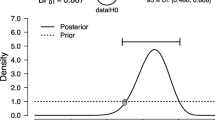Abstract
The calibration problem has been discussed widely, by many authors adopting different lines of thought: Classical, Bayesian, Structural. We face the problem of a monlinear experimental design problem and we introduce a quasi-sequential procedure to overcome the poor initial knowledge about the parameters we want to estimate. A simulation study provides empirical evidence that significant improvements can be achieved.
Access this chapter
Tax calculation will be finalised at checkout
Purchases are for personal use only
Preview
Unable to display preview. Download preview PDF.
Similar content being viewed by others
References
Elfving, G. (1952). Optimum Allocation in Linear Regression Theory. Ann. Math. Stat., 23, 255–262.
Ford I., Kitsos, C.P. and Titterington, D.M. (1989). Recent Advances in Nonlinear Experimental Design. Technometrics, 31, 49–60.
Kalotay, A.J. (1971). Structural Solution to the Linear Calibration Problem. Technometrics, 13, 761–769.
Kitsos, C.P. (1989). Fully sequential procedures in Nonlinear design problems. Comp. Stat. and Data Analysis, 8, 13–19.
Kitsos, C.P. 91986). Design and Inference for Nonlinear Problems. Ph.D. thesis, U. of Glasgow, U.K.
Kitsos, C.P. (1990). The Nonlinear Experimental Design Problem. 2nd Warld Congress of the Bernouilli Society, Aug. 13–18, Uppsala, Sweden.
Kitsos, C.P. (1987). Optimal experimental design for reaction kinetic data. 17th European Meeting of Statisticians, 24–28 Aug, Salonica, Greece.
Naes, T., and Irgens, C. (1986). Comparison of Linear Statistical Methods for Calibration of NIR Instruments. Appl. Statist, 35, 195–206.
Lwin, T. and Maritz, J.S. (1980). A Note on the Problem of Statistical Calibration. Appl. Statist., 29, 135–141.
Lwin, T., and Spiegelman, C.H. (1986). Calibration with working Standards. Appl. Statist. 35, 256–261.
Silvey, S.D. (1980). Optimal Design. Chapman and Hall.
Author information
Authors and Affiliations
Editor information
Editors and Affiliations
Rights and permissions
Copyright information
© 1992 Physica-Verlag Heidelberg
About this paper
Cite this paper
Kitsos, C.P. (1992). Quasi-Sequential Procedures for the Calibration Problem. In: Dodge, Y., Whittaker, J. (eds) Computational Statistics. Physica-Verlag HD. https://doi.org/10.1007/978-3-642-48678-4_27
Download citation
DOI: https://doi.org/10.1007/978-3-642-48678-4_27
Publisher Name: Physica-Verlag HD
Print ISBN: 978-3-642-48680-7
Online ISBN: 978-3-642-48678-4
eBook Packages: Springer Book Archive




